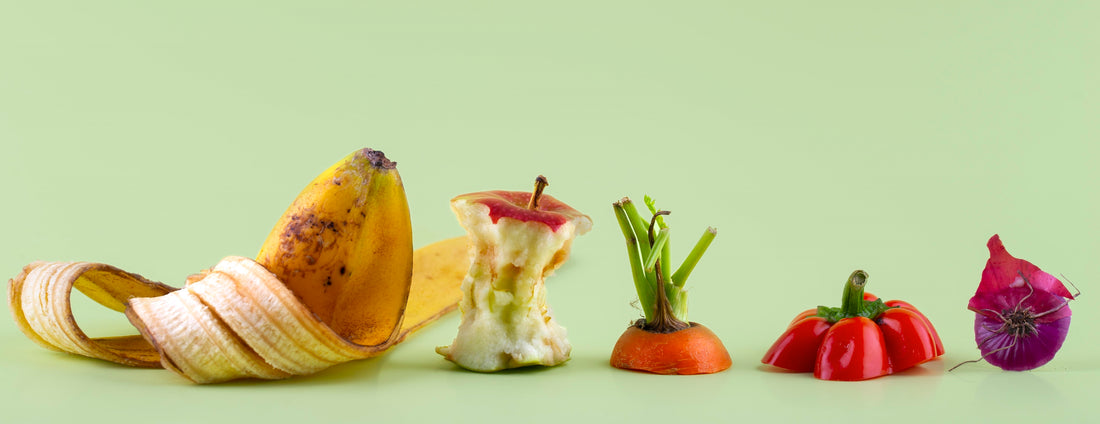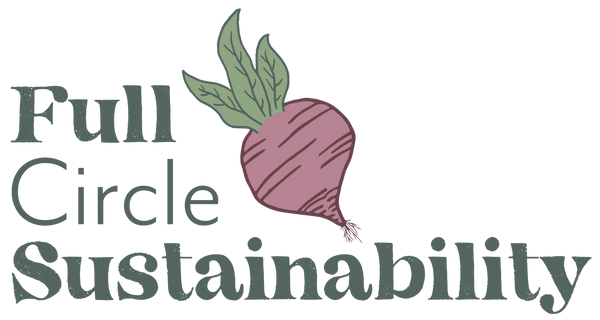
Fifteen Tips for Reducing Food Waste
Food waste statistics are simply staggering. One that I keep thinking about, even years since I first heard it: If global food waste were a country, it would have the third-highest greenhouse gas emissions of any country in the world (after China and the U.S.). Just food waste…sitting in the landfill, decomposing, emitting tons and tons of methane...more than all the people in India or Russia or the entire European Union.
Food is wasted at every point along the supply chain, so it's not all about the leftovers that went bad in the back of your fridge. But the EPA estimates that about 40% of the food waste in the U.S. occurs at the household level, so the individual impact you can make here is not insignificant.
If you’re reading this, I’m sure you hate it just as much as I do when you find mold on the bread or slime on the spinach. Food goes bad on even the most conscientious of us, but I've put together a few tips I've learned to help that happen less often.
1. First, observe. Take stock of what you throw away. Notice what you’re currently buying too much of so you can start buying less—or so you can make a plan to preserve what you may not eat in time. Also, observe what is in your fridge. Every day or two, really take a look so you know what you have and what you need to use up next.
2. Second, plan. I don’t mean you need to get a whiteboard and plan out all your meals for the week. But when you buy something, think about the whole lifespan of that grocery item (just as I’d encourage you to do for anything else you buy or bring into your home). If your recipe only calls for half the bunch of parsley, make a plan from day one to use or preserve the rest of it. That plan can be as simple as “freeze it.” But get on that right away so you don’t find the wilted, slimy leftover half bunch in the bottom of the produce drawer three weeks from now.
3. Get used to substituting. Use recipes as guides or suggestions, not lists of essential ingredients. Just as you would hesitate to buy a piece of clothing or jewelry you would only wear once, pause before buying an ingredient if you’re only likely to use a little bit. Instead, search online to find out what you can substitute instead. Check our NPR’s guide on food substitutions to get started. If it's an ingredient that's common, just not something you keep on hand, consider asking a neighbor if you can buy or borrow some.
4. Along the same lines, make substitutions to cook with what you have. If you normally put broccoli in your casserole but what you need to use up right now are carrots and zucchini...try those instead! Or make taco filling from beans, lentils, or quinoa instead of buying ground beef that you don't think you'll use up.
5. Ignore date labels (“sell by,” “use by,” etc.)—and rest assured that you have the USDA’s blessing to do so! Nearly a third of households say they often or always throw away food based on the printed date, but in most cases, that food is probably still good. Here’s the USDA on the subject:
“One source of food waste arises from consumers or retailers throwing away wholesome food because of confusion about the meaning of dates displayed on the label...With an exception of infant formula...if the date passes during home storage, a product should still be safe and wholesome if handled properly until the time spoilage is evident. Spoiled foods will develop an off odor, flavor or texture due to naturally occurring spoilage bacteria. If a food has developed such spoilage characteristics, it should not be eaten.”
Learn to trust your eyes, nose, and judgment when it comes to identifying spoiled food.
6. If the food smells off or looks like it's spoiled, don’t eat it! It’s absolutely not worth making yourself sick. But if it just has some bad spots or seems like it's just on the edge of going bad, you can probably make it safe by cooking it. Heat kills pathogens, so if you get the food up to 165° F, you should be safe.
7. Distinguish between “wilted” greens and slimy ones that are actually going bad. There’s nothing really wrong with wilted greens—wilting is what will happen when you cook them anyway! Even something you may not be used to cooking (like lettuce) can be great sautéed with a little oil and salt. Experiment to find your favorite ways to cook whatever greens are wilting.
8. If they're not actually very far gone, revive greens or celery by storing them in cold water.
9. Freeze everything! Do some quick online searching if you’re curious about what will happen to a given item, but most foods freeze fairly well. It may affect the texture, and the item may be better cooked instead of raw once it comes out of the freezer—but at least it will end up in a future meal rather than the trash!
- Freeze raw, chopped veggies to use in future recipes. Or roast and freeze veggies to thaw and eat later.
- Freeze the fruits you often find in the frozen-fruit section of the grocery store: berries and mangos, for example. Lay them out on a baking sheet in the freezer so the pieces freeze individually, then put them in a bag or larger container for storage. Bananas freeze well if you're going to use them in smoothies, baked goods, or (my favorite) banana nice cream.
- Freeze avocadoes when they're ripe so you don't miss that short, perfect ripeness window! Scoop the avocado out of the peel, freeze, and thaw later for great guacamole! It may not be quite as good as guac from a fresh avocado, but it’s not a bad substitute—and a good solution to the problem of finding an avocado that’s perfectly ripe just when you need it.
- Freeze bread and other baked goods. Make sure they’re in a well-sealed bag or container, and you won’t lose much in the way of moisture or texture.
- Cheese typically freezes well, though certain types will become a little crumbly when thawed and may be better for cooking. You can also freeze milk, half-and-half, cottage cheese, yogurt, and sour cream, though the texture won’t be quite the same afterwards. You can disguise this by using them in a dip with other ingredients or in cooked dishes.
- I never even thought about preserving eggs until I found myself with a dozen prolific chickens…then I learned eggs freeze well too! Just crack a few into a container, and thaw later to enjoy scrambled eggs when the local hens are less productive.
- Freeze chopped herbs by putting them in an ice cube tray and filling the rest of each compartment with water or oil. Pop them out to use later in soups or other cooked dishes. You can freeze sturdier herbs like parsley on a cookie sheet (so they don't clump together), then transfer to a smaller container to store.
10. Roast everything! The easiest way to cook pretty much any vegetable is to just chop it up and roast it. Roasting makes veggies sweeter, so all it takes is some olive oil, salt, pepper, and garlic to create a great side dish from anything aging in your fridge.
11. Store tofu and fresh cheese in water. Tofu and fresh cheeses like mozzarella, burrata, and feta will store longer if you submerge them in water after opening. Change the water every few days. For feta, you might add a little salt to the water as well.
12. Make broth from your food scraps. This is a great two-for-one. Avoid all those non-recyclable broth cartons, and get a second life out of carrot peels and onion skins. This traditional veggie broth or this tomatoey one would be good recipes to use to get started.
13. I wish I could tell you to compost your food scraps at Topeka's community composting center...but unfortunately that doesn't exist yet. (We'll get there one day!) If you own your own home, it's very easy to get started composting. If you don't, maybe you can find a friend with a compost pile who would be willing to merge your scraps in with theirs. You can freeze your scraps to keep them from smelling up your kitchen until you have a chance to drop them off somewhere. Another option, if you travel east frequently: Compost Collective KC has a few bin swap locations in Lawrence. And there are several composting options in Kansas City.
If you would like to see better infrastructure for composting in Topeka, contact the Shawnee County Department of Solid Waste. They have publicly expressed interested in starting a composting program, and it could only help propel the initiate along if they received messages from community members in support.
14. Explore other types of food preservation. I’ve focused here on low-effort ways to preserve your food and reduce waste because—let’s face it—a huge reason we have waste is because we’re short on time! But if time is not the issue, you can explore things like making ricotta cheese out of old milk (I’ve had success with this, but it is a bit of a process) or making refrigerator pickles (called quick pickling).
15. Use the unusual parts. Roast califlower stems or grate up broccoli stems for slaw. If you're more adventurous, try cooking with watermelon rinds or banana peels (you can make a whole breakfast out of banana peel muffins with a side of banana peel bacon)! If you're using the peel of something like a banana, do make sure to wash it very well.
Bonus Tip: Finally, start to think about food waste as lost money. It’s weird. Once I get home from the grocery store, that bunch of kale no longer feels quite the same as the few dollars it represents. Remember how much you paid for that kale or that gallon of milk, and do what you can to get all the bang out of your grocery buck!
What additional tips can you think of for reducing food waste? Let us know so we can improve and expand on the advice we share in the community!
-Justine
Credits:
Initial inspiration for this post came from an episode of NPR's Life Kit podcast: How to Cut Down Food Waste (and Fight Climate Change). Another good podcast on food waste and food rescue efforts is The Great Food Rescue from the TED Radio Hour.
Cover image by Freepik



